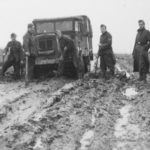Einheits-Diesel truck WL 29472 of Luftwaffe loaded onto a rail car
Radio mast motor-vehicle Kfz 68
Einheits-Lkw with Kastenaufbau Finland April 1943
Funkmastkraftwagen Kfz 68 with winter camo, Eastern Front
Fernsprech Betriebskraftwagen Kfz 61 near Sewastopol 1942
Einheitsdiesel with a field kitchen
Einheitsdiesel truck with camo
Einheitsdiesel Poland
Einheitsdiesel truck
Einheitsdiesel truck 2
Einheits-Diesel Eastern Front
Einheitsdiesel stuck in mud, Eastern Front
EinheitsDiesel of the 268. Infanterie-Division
Einheitsdiesel Munchen December 1939
Einheitsdiesel of the 5. Jäger-Division, Eastern Front
Damaged Einheitdiesel WH131830
Borgward 3t towing Einheitsdiesel LKW Summer 1942
Einheitsdiesel (Uniform Diesel), Wehrmacht truck
Einheitsdiesel german ww2 truck
Einheitsdiesel Lkw truck towing 15cm artillery, Danmark
Einheits Diesel Truck
Einheitsdiesel (Uniform Diesel) – military truck
Einheitsdiesel wehrmacht truck photo
Einheitsdiesel wehrmacht lastkraftwagen
Einheitsdiesel Wehrmacht truck
Einheitsdiesel kfz 62
Einheitsdiesel truck in winter
Einheitsdiesel (Uniform Diesel) Wehrmacht truck 33
Einheitsdiesel wehrmacht truck 3
Einheitsdiesel Wehrmacht truck 16
Einheitsdiesel Wehrmacht truck 1
Luftwaffe truck Einheitsdiesel with 2 cm flak
Einheitsdiesel (Uniform Diesel) wehrmacht truck lkw
Einheitsdiesel ww2 wehrmacht truck
Einheitsdiesel wehrmacht truck 2
Wehrmacht ww2 standard truck (Einheits-Lastkraftwagen).
Yet, in 1934 Heereswaffenamt worked out the plan of the standard chassis production for military cars. It was to limit a great number of different types of cars used in the German army. Besides these three types of chasses for off-road passenger cars, also one for light off-road truck in 6×6 configuration. These vehicles marked Einheits-Diesel (le. E. Lkw.) were manufactured in 1937-1940 simultaneously by several companies in the number of almost 12 000 representatives. The construction of medium and heavy standard trucks was resigned mainly because of enormous costs of the project realization. Almost all important German car companies were engaged in the works over Einheitsdiesel. Engineers from MAN, Henschel and Humboldt-Deutz plants worked with the construction of diesel engines. Bussing-NAG, Daimler-Benz, Hansa-Lloyd-Goliath, Henschel, Humboldt-Deutz, Junkers, Kamper, Krupp, MAN and Vomag took up a bulk production of the engine. After the bulk production of the truck, Kamper still manufactured spare parts needed for current service. A fuel injection pump and injectors with pneumatic regulator were made by Bosch and Deckel. The clutch was made by Fichte&Sachs, the gear box was made by Berlin Promotheus company. The brake system, steering, cylinders, valves were the masterpiece of Bosch and Knorr. In chassis construction Henschel plants were engaged. They were supported by MAN engineers and they worked out additionally a vertical winch situated at the back. It is obvious that such a great number of companies surely did not favour the fast progress of works, therefore, it increased costs of the whole program. A new truck was officially named leichte Einheits-Lastkraftwagen (le. E. Lkw.) but it was commonly called Einheitsdiesel. The bulk production was started officially in 1937, however, some factories started assembly not until 1938. After the outbreak of war and implementing the program of general von Schell to be realized the realization of the whole Einheits program, including trucks, was discontinued. Except from high costs and high sophistication of the production, poor performance, problems with service and little load amounting maximum 2500 kg were the reason for that. Einheitsdiesel (6×6) was produced barely until 1940. Most of produced vehicles targeted Wehrmacht, and only small number for export to Bulgaria (over 160 trucks), Romania and probably a few other allied armies. Einheitdiesels (6×6) were used mainly in a transport version with an open body and a cabin covered only with a tarpaulin roof.
Manufacturers: Büssing-NAG, Daimler-Benz, Faun, Vomag, Henschel, Krupp, Magirus, MAN and Borgward. Production: over 14000


































